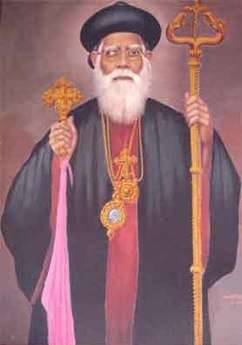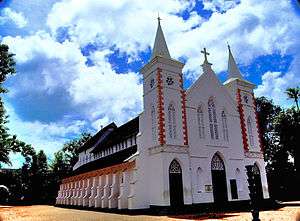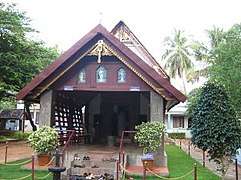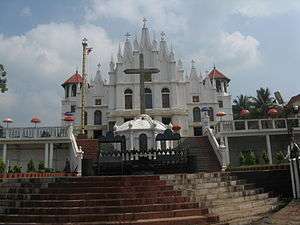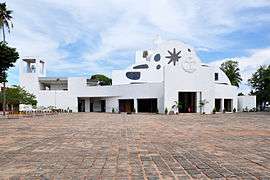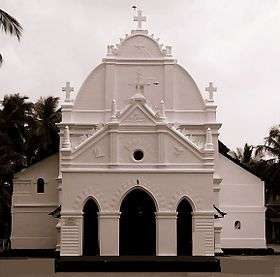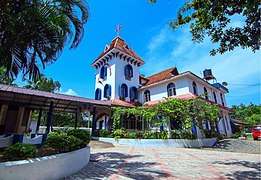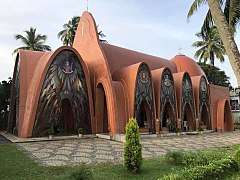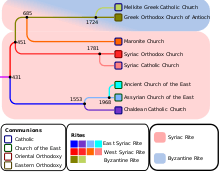Malankara Orthodox Syrian Church
 Malankara Orthodox Syrian Church (Indian Orthodox Church) | |
|---|---|
| Malayalam: മലങ്കര ഓർത്തഡോക്സ് സുറിയാനി സഭ | |
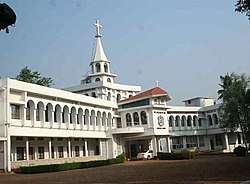 Catholicate Palace, Devalokam | |
| Classification | Oriental Orthodox |
| Theology | Miaphysitism |
| Polity | Episcopal |
| Primate | Catholicos of the East and the Malankara Metropolitan present Baselios Mar Thoma Paulose II |
| Region | India, Canada, Africa, Ireland, United Arab Emirates, Malaysia, New Zealand, Singapore, United Kingdom, Australia and the United States |
| Language | Malayalam, Syriac, English, Hindi, Konkani, Kannada, Tamil |
| Headquarters | Kottayam, Kerala, India |
| Founder | Saint Thomas |
| Origin | AD 52[1][2] |
| Branched from | Saint Thomas Christians |
| Members | 2.5 million[3] |
| Other name(s) | Orthodox Syrian Church of the East[4] |
| Official website | Malankara Orthodox Church |
| Part of a series on |
| Oriental Orthodoxy |
|---|
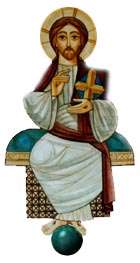 |
| Oriental Orthodox churches |
|
Subdivisions
|
|
History and theology
|
|
Major figures
|
|
|

The Malankara Orthodox Syrian Church,[5] also known as the Indian Orthodox Church,[6] is an autocephalous[7][8] Oriental Orthodox church centered in the Indian state of Kerala. It is one of the churches of India's Saint Thomas Christian community, which has its origin in the evangelical activity of Thomas the Apostle in the 1st century.[9] The church is headed by the autocephalous[10] Catholicos of the East and the Malankara Metropolitan, presently Baselios Mar Thoma Paulose II.
History
It is believed that Saint Thomas Christians of Malabar were in communion with the Church of the East from 496 to 1599.[11] They received episcopal support from Persian bishops, who traveled to Kerala in merchant ships through the spice route, while the local leader of the Saint Thomas Christians held the rank of Archdeacon and was a hereditary office held by the Pakalomattam family. In the 16th century, the overtures of the Portuguese padroado to bring the Saint Thomas Christians into Latin Rite Catholicism led to the first of several rifts in the community by Portuguese colonialists and the establishment of the Catholic and the Malankara Church factions. Since then, further splits have occurred, and the Saint Thomas Christians are now divided into several fragments, due to western interferences.
Saint Thomas Christians were administratively under the single native dynastic leadership of an Archdeacon (a native ecclesiastical head with spiritual and temporal powers, deriving from Greek term arkhidiākonos) and were in communion with the Church of the East, centered in Persia, from at least 496.[12][13] The indigenous Church of Malabar/Malankara followed the faith and traditions handed over by the Apostle St. Thomas. During the 16th century, the Portuguese Jesuits began deliberate attempts to annex the native Christians to the Catholic Church, and in 1599 they succeeded through the Synod of Diamper. Resentment against these forceful measures led the majority of the community under the Archdeacon Thomas to swear an oath never to submit to the Portuguese, known as the Coonan Cross Oath, in 1653. The Malankara Church consolidated under Mar Thoma I welcomed Gregorios Abdal Jaleel, who regularized the canonical ordination of Mar Thoma as a bishop.
Meanwhile, the Dutch East India Company defeated the Portuguese in supremacy of the spice trade in Malabar in 1663. The Malankara church used this opportunity to escape from Catholic persecution with the Dutch East India Company's help. At the request of the Malankara Church, the Dutch brought Gregorios Abdal Jaleel of Jerusalem, a bishop of the Syriac Orthodox Church, in their trading vessel in 1665. Mar Thoma I forged a relationship with the Syriac Orthodox Church and gradually adopted West Syrian liturgy and practices.
Early history
The East Syriac Prelate, Mar Yuhanon signed on behalf of the Churches of Persia and India at the first organized gathering of Christianity, the Synod of Nicea held in 325 AD. The East Syriac Canonist Ibn Tayyib says ‘In the time of Catholicose Mar Ishaq (309-410) the Metropolitanates of Fars and Meru and in the time of Mar Ishu Yab-I/ II/ III (582-660) Halwan, Harat, Samarkhand, India and China were created’. Mar Ishu Yab warned in his two letters to Mar Shimyun, Metropolitan of Fars (Riwardisher) located in southern Persia that his independent stand will not hamper the ecclesiastical needs of the people of India. Ancient East Syriac (Persian) crosses found out in many places with writings in Pahlavi language engraved on it, as seen at Kadamattom Orthodox church, Kottayam Canaanite church, Mylapore church are also pronounce our close relationship with Eastern Church.
Malankara Nazranies also had evolved a script (Karshoni) to write Malayalam after making certain changes in East Syriac script, even though ‘Vattezhuthe’ an early form of Malayalam was in vogue. The present-day Malayalam script was formulated and used by Indo-Aryan settlers on the lines of Devnagari for the translation of their Epics to Malayalam after 12th century. Aarthat Padiyola in copper plate (preserved at University Manuscript Library, Trivandrum), declaring the sovereignty of Malankara Church in 1806 was written in old Malayalam script. An early script, ‘Kharoshti’ (used in Ashoka edicts) prevailed in northwestern India was also developed from eastern Syriac, which helped to decipher identical edicts written in India's original but defunct Prakrit languages. Even many documents related to 17th and 18th century also reveals the attachment of Nazranis to Eastern Syria. A memorandum by Malankara Nazranis to Roman Pope against compulsive westernization during the 17th century states that, "All our prayers are written in the Chaldean Syriac of our Apostle father St. Thomas". A Jesuit priest Nunes Barutha of that period states that : "Marthoma Christians are not believe in any other teaching other than written in Eastern Syriac". In 1682, Bartholomew, a West Syrian Malpan from Aleppo was appointed in Verapoly seminary by Carmelites. But Malankara Nazranis strongly opposed the appointment to teach their students by a West Syrian teacher. Canon of Udayamperoor synod (page 79)specifically asked to discontinue the use of Eastern Syriac in liturgy and prayers for native Malayalam. Eastern Aramaic (Syriac) was widely used in Malankara up to the 17th century, and all borrowed words and names from Syriac to Malayalam are phonetically in Eastern Syriac. Later, Malankara Nazranis were almost adapted to Western Syriac and liturgy due to ecclesiastical support and long stay of many Antiochean prelates in the second half of 17th and 18th centuries.
At the outset of Latinisation, Nazranis were reluctant to accept Latin bishops. When Vasco-da-Gama arrived in Cochin in 1502, Metropolitan Mar Yahb Alla assisted by Mar Denha, Mar Yacob and Mar Yuhanon sent by Babylonian Patriarch (See of East Syriac Catholicosate shifted from Selucia to Baghdad began to known as Patriarch) ministered from Ankamaly along with Arkidhyaquana. Cardinal Tisserent in his book ‘Eastern Christianity’ states that even after the arrival of Portuguese, Babylonian Primates, continued to send prelates and they ministered in Malanakara viz. Mar Yacob (1503–49), Mar Joseph and Mar Elias (1556–69), Mar Abraham (1568–97) and thereafter Mar Simeon. Most of them were detained by Portuguese under Goan Inquisition and sent to Bassein (Vasai), Lisbon or Rome for orientation in Latin language, tradition and liturgy. In 1601, Menezes consecrated Fr. Francis Roz as bishop of Ankamaly, which marked the beginning of Roman Catholic hierarchy in Malankara. In 1652, Mar Ahathalla, a prelate from East Syria reached Mylapore (most emotive place in India for every East Syriac in early times) and the news of his detention and torture by Portuguese, caused the great uprising of 1653 known as ‘Coonan (bend) Cross Oath’ in which Malankara Nazranes proclaimed that they or their descendants will not make any relation with Rome and elevated Thomas Arkidhyaquana as Metran (bishop) by laying hands on him by 12 Priests.
Meantime, the Capuchin missionaries catholicized and formed Chaldean Catholic Church and restricted their old tradition to send bishops to Malankara. In light of such a circumstance, to get Apostolic Hand to the newly elevated bishop, the orthodox Churches like Antioch and Alexandria were contacted through the Dutch East India Co. due to their vast mercantile connections in cities and ports. Antiochean Church was the first to respond, sending their Jerusalem Bishop, Mor Gregorios, via a Dutch ship, reaching Malankara in 1665. The Dutch who defeated Portughese in 1663 for trade monopoly and the Malankara Church wanted to escape from the clutches of the Portuguese and caused to the arrival of many more contingent of Antiochean prelates, including Maphriyonos of Mosul, Eldho Mar Baselios (passed away on the 8th day of his arrival and considered as a saint, whose mortal remain is interned at Kothamangalam) and then Mar Sakralla with a team of Metropolitans and priests. When Malankara Syrians began to accept Antiochean prelates, Roman faction got an opportunity to call Malankara people as ‘Puthenkootukar’ (new tradition) and call themselves as ‘Pazhyakootukar’ (old traditionalists) to cover up their 54 years of new European relation. In fact, Latin rites introduced in Malankara by Menezes were much more strange and unfamiliar than West Syrian rites for Malabar Christians who were traditionally accustomed with Syrianism. Moreover, they found the west Syrian liturgy and rites to be much attractive due to their perceived "pure Syrian tradition".
Latin Catholicism failed to attract Malankara Nazranis, hence Portuguese had to resort to appeasement as well as to pressure tactics to bring Syrians into their fold. In the Coonan Cross Oath almost total strength of Syrians supported Arkidhyaquana, but within few decades, majority of churches were annexed to Romanism. Kerala's long water ways helped the Portuguese soldiers to directly intervene in coastal churches, while geographically interior churches spared due to lack of roads at that time. They asked Kochi, Vadakkumkoor, Thekkumkoor and Ambalapuzha kings to put diktats to their Syrian subjects to join Catholicism.
Please see
Church Constitution
The church had no written constitution until 1934, but was governed by consensus, traditions and precedence. It was the vision of Mor Dionysius, Vattasseril, to have a clearly defined uniform constitution to govern the church administration. He initiated action and appointed a sub-committee with O.M. Cherian as convener to submit a draft constitution. The committee members had discussed the fundamental issues with the Metropolitan in several rounds, but it was not finalized and passed (materialized) in Cherian's lifetime.
After his demise, the constitution was presented in the Malankara Christian Association meeting of 26 December 1934, held at M. D. Seminary. It was adopted and brought to force. The constitution has been amended three times to meet specific situations and needs. The validity of the constitution was challenged by the Patriarch party in the Court, but the Supreme Court's final verdict declared the validity of the Constitution. Every member of the Church is bound by the rules and regulations laid down in the Constitution.
The Constitution upholds the autonomy and autocephaly of the Malankara Orthodox Church. It is Episcopal in its (polity) and not congregational. At the same time it upholds democratic principles by safeguarding the rights and privileges of the lay men. The constitution enshrines the fundamental features of the Church, provides direction for its internal administration, and preserves its integrity and autonomy. The essential features of the Church are provided in the preamble.
The first article emphasizes the bond of relationship between the Orthodox Syrian Church and the Malankara Church. It defines both Malankara Church and Orthodox Syrian Church are sister churches and both heads of Churches are to be mutually respected and accepted in their respective Sees.[14] The second article says about the foundation of the Malankara Church by St. Thomas and the primate of the Orthodox Syrian Church of the East as the Catholicos. The third article refers to the name of the church and the fourth about their faith traditions. The fifth is about the canons governing the administration of the Church.
The whole constitution conceives the Malankara Church as self-sufficient in all her requirements, be it temporal, ecclesiastical, or spiritual in nature, and upholds that the Malankara Orthodox church is rightly autocephalous in character.
20th century
Geevarghese Mar Dionysius of Vattasseril, who ascended the throne of Malankara Metropolitan in 1908, played a significant role with the other clerical and lay leaders of Malankara in re-establishing the Catholicos of the East in India in 1912. The Malankara Orthodox Syrian Church wanted to retain its autocephalous nature. It appealed to the deposed Syriac Orthodox Patriarch of Antioch, Mor Ignatius Abdul Masih II. He ordained Murimattathil Paulose Mar Ivanios as Baselios Paulose I, as Catholicos of the East on the Apostolic throne of St. Thomas. The ceremony was held at St. Mary's Church, Niranam on 15 September 1912.[15] The church in the 20th century remained the most favored and strong denomination to be fully eligible for St. Thomas heritage. The lineage of St. Thomas is preserved based on two grounds. Firstly, the founder and first primate of the Church is St. Thomas, the Apostle of Jesus Christ; and secondly, the church has no dependence on nor is under any foreign churches outside India (in short, autonomous and autocephalous).
The history of immigrant community of the Malankara Orthodox Syrian Church of the East in the United States begins approximately in the mid-20th century. During this period a number of priests and laity came to the US for higher studies and training. Mathews Mar Coorilos Metropolitan (later Moran Mar Baselius Mar Thoma Mathews II) stayed at the General Theological Seminary in 1963 and returned to India in 1964. Mar Coorilos celebrated Holy Qurbana occasionally during his stay there. Fr. K.M. Simon looked after the Church service after Mar Coorilos left for India. This service was ecumenical in nature; Malayalees of any denomination participated.
In 1965, the United States Congress passed a bill which cleared the way for thousands of professionally qualified individuals to immigrate to the US. Many Malankara Orthodox Christians came to the United States during this time. In 1968 Fr. G. John (John Geevarghese), an Ecumenical Fellow at Union Theological Seminary in New York City, started celebrating the Holy Qurbana every Sunday in the Seminary chapel, thus organizing the first congregation on America soil. After 1970, the Malankara Orthodox Church gradually spread to many major US cities with increasing numbers of clergy and laity. In 1976, the Holy Synod decided to establish more dioceses in various parts of the world. At this time, the numerous churches in America were placed under the authority of the Metropolitan of the Bombay Diocese, Thomas Mar Makarios. On 14 July 1979, Mar Makarios was given authority over the new American Diocese under the authority of the Catholicos of the East, Baselius Mar Thoma Mathews I. In 1991, Mathews Mar Barnabas took charge of the diocese. In 2002, Zacharias Mar Nicholovos joined the diocese. In 2009, the 'American Diocese' was split into the Northeast American Diocese and the Southwest American Diocese. As of 2013, the Northeast American Diocese had more than fifty parishes, more than forty priests, and fourteen deacons and seminarians.
Hierarchy, distribution and doctrine
The spiritual regional head of the church is the Catholicos of the East and the temporal head over church assets is the Malankara Metropolitan. Since 1934, both the titles vest in one person. The official title of the head of the Church is the "Catholicos of the East and the Malankara Metropolitan". Baselios Mar Thoma Paulose II was enthroned as Catholicos of the East on 1 November 2010 at Parumala Church by the Holy Synod, the 91st Catholicos of the East in the lineage of Apostle Thomas, the eighth after reinstatement in India, and the twentieth Malankara Metropolitan.
Oriental Orthodox Churches, including the Malankara Orthodox Syrian Church, accept only the first three Ecumenical Synods.
Malankara Orthodox Syrian Church, as all other Oriental Orthodox Churches, uses the original Nicene-Constantinopolitan Creed,[16] without the Filioque clause.[17]
The church primarily uses the liturgy of Saint James, as does its sister church, the Syriac Orthodox Church of Antioch. The Church in India was connected to the Church of East through the Catholicos of the East, existed in Edessa, Selucia, Tigris and Mosul at various times. Today the Church conducts liturgy in West Syriac Rite, Malayalam, Hindi and English.
The church has theological seminaries at Kottayam and Nagpur, and dioceses and churches in most parts of India, the United States, Canada, United Kingdom, Western Europe, Africa, Persian Gulf nations, Malaysia, Singapore, Australia and New Zealand.
The name Malankara Orthodox Syrian Church refers to St. Thomas Christians of India that come under the Catholicate of the East whose supreme head is the Catholicos of the East and Malankara Metropolitan, with its headquarters at Devalokam, Kottayam, Kerala, India.
Liturgy
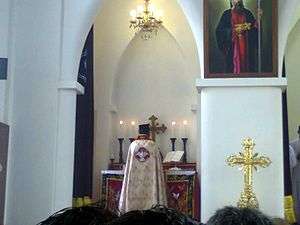
Since the 17th century, the Malankara Church uses the Malankara Rite, which belongs to the Antiochene liturgical tradition. The East Syriac (Persian), Byzantine, Armenian, Georgian and Maronite liturgies also belong to the same liturgical family. In the first half of the 5th century, the Antiochene Church adopted the anaphora of Jerusalem, known under the name of St James the disciple. In the 4th and 5th centuries, the liturgical language of Jerusalem and Antioch was Greek. Therefore, the original form of St James liturgy was composed in Greek.
Following the Council of Chalcedon in 451, the Eastern Church was divided into two, one group accepting the council and the other opposing it. Both groups continued to use the Greek version of St James. The Byzantine emperor Justin (518–527) expelled the non-Chalcedonians from Antioch, and they took refugees in the Syriac speaking Mesopotamia on the Roman–Persian Border (modern Eastern Syria, Iraq and South East Turkey). Gradually, the Antiochene liturgical rites were translated into Syriac. New elements such as Syriac hymns were introduced into it.
Mar Gregorios of Jerusalem came to Malankara in 1665 and introduced Syriac Orthodox liturgical rites. The most striking characteristic of the Antiochene liturgy is the large number of anaphoras (Order of the celebration of the Eucharist). About eighty are known and about a dozen are used in India. All of them have been composed following the model of Liturgy of St James.[18]
- The ritual service (liturgy) is called the Holy Qurbana, which is derived from the Aramaic word korban (Hebrew: קרבן), meaning "sacrifice".
- The Holy Qurbana is mostly conducted and prayers recited in Malayalam. However, some parts of the Holy Qurbana are sung in Syriac. During the 20th century the 'Qurbana-kramam' (i.e. the 'book containing the order of worship') was translated into English, for the benefit of worshipers who lived outside Kerala, who did not know to read or write Malayalam.
The Catholicate
The word "Catholicos" means "The General Head". It can be considered as equivalent to "Universal Bishop". There were only three ranks of priesthood in the early Church: Episcopos (Bishop), Priest and Deacon. By the end of the 3rd century, certain bishops of certain important cities in the Roman Empire gained pre-eminence over other bishops and they came to be known as Metropolitans. The Ecumenical councils of the 4th century recognized the supreme authority of these Metropolitans. By the 5th century the bishops in major cities such as Rome, Constantinople, Alexandria and Antioch gained control over the churches in the surrounding cities. Gradually they became the heads of each independent regional church and were called Patriarch, which means common father. The same rank in the Churches outside the Roman Empire was called Catholicos. There were four ancient Catholicates in the Church before the 5th century. They were the Catholicate of the East, the Catholicate of Armenia, the Catholicate of Georgia and the Catholicate of Albania. None of these ranks and titles are the monopoly of any church. In Orthodox tradition, any Apostolic and autonomous national church (often referred to as local Church) has the authority to declare and call its head Catholicos, Pope or Patriarch.
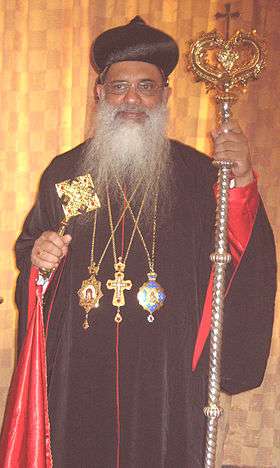
The reign of the Archdeacons started from the 4th century and lasted until the 16th century. The third stage started when the archdeacon was elevated to the position of a bishop by the community with the name Marthoma I in 1653. Since then the head of the community was the Marthoma Metrans and later the position was developed to Malankara Metropolitan with more recognition.
In 1912, the Catholicate of the East was relocated to India, and Baselios Paulose I was seated on the Honorary Apostolic Throne of St. Thomas as the Catholicos of the East. The Headquarters of the Malankara Orthodox Syrian Church is the Catholicate Palace located at Devalokam, Kottayam, in Kerala state of India. It is the official headquarters of the Catholicos of the East who reigns on the Supreme Throne of St. Thomas the Apostle. This seat of the Primate of the Church was consecrated on 31 December 1951. Mar Elia Cathedral, Kottayam is the Thronal Cathedral of the Catholicos of the East.
The new Aramana (palace) which was built in 1961 was inaugurated by the visiting Armenian Catholicos Vazgen I.
Holy relics of St. Thomas the Apostle are kept in the Catholicate Chapel. The mortal remains of Baselios Geevarghese II, Baselios Augen I, Baselios Mar Thoma Mathews I and Thomas Mar Makarios Metropolitan are entombed in this chapel.
List of Catholicos of the East
The Malankara Orthodox Syrian Church was founded by St. Thomas, one of the twelve apostles of Jesus Christ, who came to India in 52 AD.
At least from the fourth century the Indian Church entered into a close relationship with the Persian or East Syriac Church. From the Persians, the Indians inherited East Syriac dialect in liturgical use and gradually came to be known as Syriac Christians in India.
In the sixteenth century Roman Catholic missionaries came to Kerala. They tried to unite the Syrian Christians to the Roman Catholic Church and this led to a split in the community. Those who accepted Catholicism are the present Syro-Malabar Catholics. Later, Western Protestant missionaries came to Kerala and worked among Syrian Christians; the first few decades of cooperation was cordial, but dogmatic differences and colonial nature of the missionaries created splits in the community.
In the seventeenth century, the Church came to a relationship with the Antiochene Church which again caused divisions. As a result of this relationship the Church adopted West Syrian liturgies and practices.
The Church entered into a new phase of its history by the establishment of the Catholicate in 1912.
At present the Church is using the West Syrian liturgy. The faith of the Church is that which was established by the three Ecumenical Councils of Nicea (325 AD), Constantinople (381 AD) and Ephesus (431 AD).
The Church is in communion with the other Oriental Orthodox Churches namely, Coptic, Armenian, Syriac, Ethiopian and Eritrean Orthodox Churches. The Church is in good ecumenical relationship with the Eastern Orthodox, Roman Catholic and Protestant Churches.
At present the Church has over 2 million faithful with 30 dioceses all over the world.
Saints of the Church
- Parumala Thirumeni (Geevarghese Mor Gregorious, Entombed in Parumala Church) (Canonized by the Holy Synod, in 1947, led by Catholicos Baselios Geevarghese II)
- Baselios Yeldo (Yeldo Mor Baselious, Entombed in Marthoma Cheriapally Kothamangalam (Canonized by the Holy Synod, in 1947, led by Catholicos Baselios Geevarghese II)
- Geevarghese Mar Dionysius of Vattasseril (Entombed in Old Seminary) (Canonized by the Holy Synod, in 2003 led by Catholicos Baselios Mar Thoma Mathews II)
Current Metropolitans
- Baselios Mar Thoma Paulose II (Catholicos of the East and Malankara Metropolitan), [Baselios Mar Thoma Paulose II]] (Catholicos of the East and Malankara Metropolitan), Kottayam Central, Kunnamkulam
- Dr. Thomas Mar Athanasius – Kandanad East
- Dr.Yuhanon Mar Meletius – Thrissur
- Kuriakose Mar Clemis – Thumbamon
- Zachariah Mar Anthonios – Kollam
- Geevarghese Mar Coorilos – Bombay
- Zachariah Mar Nicholovos – Northeast America
- Mathews Mar Severios – Kandanad West
- Yacob Mar Irenaios – Kochi
- Gabriel Mar Gregorios -Trivandrum
- Yuhanon Mar Chrysostomos – Niranam
- Yuhanon Mar Policarpos – Ankamali
- Mathews Mar Theodosius – Idukki
- Joseph Mar Dionysius – Calcutta
- Abraham Mar Ephiphanios – Sulthan Bethery
- Mathews Mar Thimothios – UK, Europe, Africa
- Alexios Mar Eusebius – South-West America
- Yuhanon Mar Dioscoros – Madras, Kottayam
- Yuhanon Mar Dimitrios – Delhi
- Yuhanon Mar Thevodoros – Kottarakara – Punalur
- Yakob Mar Elias – Brahmavar
- Joshua Mar Nicodimos – Nilackal- Ranni. mavelikara
- Zacharias Mar Aprem – Adoor – Kadampanadu
- Geevarghese Mar Yulius – Ahmedabad, Kunnamkulam
- Abraham Mar Seraphim – Banglore
Theological seminaries
A number of seminaries are present in the Church. Most of them which currently serve as monasteries functioned in full capacities at one time or the other. At present, the two seminaries that offer bachelor's and master's degrees in theology include:
- Orthodox Theological Seminary, Kottayam.[19] Also known as Pazhaya Seminary / M.D Seminary
- St. Thomas Orthodox Theological Seminary, Nagpur[20]
Ecumenical relations
The Malankara Orthodox Syrian Church was a founding member of the World Council of Churches.[21]
Various theologians were involved in negotiations between the Oriental Orthodox and the Byzantine churches. The Indian Orthodox Church participated in the Ecumenical Council of Oriental Orthodox Churches held in Addis Ababa, in 1965. The contributions of theologians including Paulos Mar Gregorios, Geevarghese Mar Osthathios, Fr. Dr. V. C. Samuel to ecumenism and theological dialogue are respected across the Christian world.
Other organizations to which the church belongs are
- Faith and Order Commission
- Christian Conference of Asia
- Global Christian Forum
Churches with historical importance
- Parumala Church (St. Peter's & St. Paul's Orthodox Church, Parumala)
- Kottayam Cheriapally
- St. Mary's Orthodox Cathedral, Thumpamon (Thumpamon Valiya Pally)
- Pampakuda Cheriapally (St. Thomas Church, Pampakkuda)
- Niranam Church
- Thiruvithamcode Arappally
- Puthupally Palli
- Arthat St. Mary's Cathedral Church](Arthat Valliyapally), Kunnamkulam
- Kallooppara St. Mary's Orthodox Church
- Vakathanam Vallikkattu Dayara
- Paliakkara Church, Thiruvalla
- Kadeesa Syrian Church, Kollam
- Kadeesa Syrian Church, Kayamkulam
- Kadamattom Church
- Coonan Cross Oath Memorial Holy Cross, St. George Orthodox Church, Mattancherry
- Martha Mariam Orthodox Syrian Church & Mar Abo Pilgrim Centre, Thevalakkara
- Pazhanji Palli (Officially Called as St. Mary's Orthodox Syrian Church Pazhanji )
- St. George Orthodox Church, Chandanapally
- St. Thomas Orthodox Cathedral, Kadampanadu (Marthoman Pilgrim Center, Kadampanadu, Adoor)
- St. Mary's Orthodox Church, West Kallada.(Kallada Valiyapally)
- St. Mary's Orthodox Cathedral. Puthiyakavu, Mavelikara (Puthiyakavu Pally)
- St. Mary's Orthodox cathedral Puthencavu, Chengannur
- St. George's Orthodox Valyapally, Cheppad (Cheppad Valiya Pally)
- St. Peter's & St. Paul's Syrian Orthodox Church, Kolenchery (Kolenchery Valiya Pally)
- St. Thomas Cathedral, Karthikappally (Kottakakatthu Suriyani Palli)
- St. Thomas Orthodox Church, Kundara (Kundara Valiya Pally)
Dioceses
- Thiruvananthapuram Diocese
- Kollam Diocese
- Kottarakkara Punaloor Diocese
- Adoor Kadampanad Diocese
- Thumpamon Diocese
- Nilakal Diocese
- Mavelikara Diocese
- Chengannur Diocese
- Niranam Diocese
- Kottayam Diocese
- Kottayam Central Diocese
- Idukki Diocese
- Kandanad West Diocese
- Kandanad East Diocese
- Kochi Diocese
- Angamaly Diocese
- Thrissur Diocese
- Kunnamkulam Diocese
- Malabar Diocese
- Sulthan Bathery Diocese
- Brahmavar Diocese
- Bangalore Diocese
- Madras Diocese
- Mumbai Diocese
- Ahmedabad Diocese
- Delhi Diocese
- Kolkata Diocese
- UK, Europe and Africa Diocese
- Northeast America Diocese
- Southwest America Diocese
Malankara Association
The Malankara Association is the elected body consisting of members from parishes which manages and controls the religious and social concerns of the church. Traditionally convened as the Malankara Palli-yogam (മലങ്കര പള്ളി യോഗം, meaning Parish assembly of Malankara), the modern form of the association is believed to have been established in 1873 by Pulikkottil Joseph Mar Dionysious II by convening a meeting of the parish representatives in Parumala. In 1876, Mulanthuruthy Synod, an elected body in the name of the Malankara Association officially took charge.[23] Church constitution details the powers and responsibilities of the association.
The Malankara Metropolitan is the president, and the Diocesan Metropolitans are the vice-presidents of the association. The association elects the Malankara Metropolitan, Catholicos of the East, Metropolitans, Priest Trustee, lay trustee, Association Secretary and Managing Committee Members. Each parish is represented in the association by a priest, and lay people elected by the parish general body, proportionate to the membership strength of each parish.
Major Shrines
See also
Notes
- ↑ Ameerudheen, TA. "A century-old church dispute in Kerala flares up again as Supreme Court rejects plea on leadership". Scroll.in. Archived from the original on 26 July 2018. Retrieved 22 March 2018.
- ↑ "Schism in Malankara Church snowballs into law and order issue". The Hindu. 20 February 2008. Archived from the original on 29 June 2018. Retrieved 22 March 2018.
- ↑ http://www.cnewaindia.in/default.aspx?ID=9&pagetypeID=9&sitecode=CA&pageno=1
- ↑ Malankara Orthodox Church, English Version. "MOSC Constitution" (PDF). Archived (PDF) from the original on 20 April 2018. Retrieved 20 April 2018.
- ↑ Thomas Arthur Russell (2010). Comparative Christianity: A Student's Guide to a Religion and Its Diverse Traditions. Universal-Publishers. p. 40. ISBN 978-1-59942-877-2.
The Malankara(Indian)Orthodox Church of India(also called by a variety of names, such as the Malankara Orthodox Syrian Church, or the Syrian Church in India). It is located in Kerala, India.
- ↑ John; Anthony McGuckin (November 2010). The Encyclopedia Of Eastern Orthodox Christianity, 2 Volume Set. West Sussex: Wiley-Blackwells. p. 878. ISBN 978-1-4443-9254-8.
The Malankara Orthodox Syrian Church, also known as Indian Orthodox Church, is one of the major and oldest churches in India. The church is believed to have been founded by the Apostle St. Thomas in 52
- ↑ Lucian N. Leustean (2010). Eastern christianity and the cold war, 1945–91. New York: Routeledge Taylor&Francis Group. p. 317. ISBN 0-203-86594-4.
India has two main Orthodox churches, the autocephalous Malankara Syrian Church and autonomous Malankara Jacobite Syrian Orthodox Church under jurisdiction of Syrian Patriarchate. However, in 1912 there was a split in the community when one part declared itself an autocephalous church and announced the re-establishment of the ancient Catholicosate of the East in India. This was not accepted by those who remained loyal to the Syrian Patriarch. The two sides were reconciled in 1958 when the Indian Supreme Court declared that only the autocephalous Catholicos and bishops in communion with him had legal standing. But in 1975 the Syrian Patriarch excommunicated and deposed the Catholicos and appointed a rival, an action that resulted in the community splitting yet again. On 21 January 1995 the Supreme Court of India stated the existence of one orthodox church in India divided into two groups and recognised spiritual authority of the Syrian Patriarchate, acknowledging at the same time the rights of the autocephalous Church
- ↑ Fahlbusch; Lochman; Mbiti; Pelikan (November 2010). The Encyclopedia Of Christianity, Volume 5 S-Z. Gittingen, Germany: Vandenhoeck&Rupercht. p. 285. ISBN 978-0-8028-2417-2.
The autocephalous Malankara Orthodox Syrian Church is governed by Holy Episcopal Synod of 24 Bishops presided over by His Holiness Moran Mar Baselios Mar Thoma Didimos catholicos of the east
- ↑ The Encyclopedia of Christianity, Volume 5 by Erwin Fahlbusch. Wm. B. Eerdmans Publishing – 2008. p. 285. ISBN 978-0-8028-2417-2.
- ↑ http://www.cnewa.org/default.aspx?ID=9&pagetypeID=9&sitecode=hq&pageno=1 Archived 3 July 2016 at the Wayback Machine. |quote= However, in 1912 there was a split in the community when one part declared itself an autocephalous church and announced the re-establishment of the ancient Catholicosate of the East in India. This was not accepted by those who remained loyal to the Syrian Patriarch. The two sides were reconciled in 1958 when the Indian Supreme Court declared that only the autocephalous Catholicos and bishops in communion with him had legal standing. But in 1975 the Syrian Patriarch excommunicated and deposed the Catholicos and appointed a rival, an action that resulted in the community splitting yet again. In June 1995 the Supreme Court of India rendered a decision that (a) upheld the Constitution of the church that had been adopted in 1934 and made it binding on both factions, (b) stated that there is only one Orthodox church in India, currently divided into two factions, and (c) recognized the Syrian Orthodox Patriarch of Antioch as the spiritual head of the universal Syrian Church, while affirming that the autocephalous Catholicos has legal standing as the head of the entire church, and that he is custodian of its parishes and properties. This decision did not, however, result in a reconciliation between the two groups, which in 2007 remained separate and antagonistic.
- ↑
- ↑ Frykenberg, p. 93.
- ↑ Wilmshurst, EO, 343
- ↑ MOSC. Constitution:First clause and second clause.
1. The Primate of the Orthodox Syrian Church is the Patriarch of Antioch. 2. The Malankara Church was founded by St. Thomas the Apostle and is included in the Orthodox Syrian Church of the East and the Primate of the Orthodox Syrian Church of the East is the Catholicos.
- ↑ "About the church". Niranam St. Mary's Orthodox Syrian Church. 2009. Archived from the original on 27 January 2010. Retrieved 25 April 2010.
- ↑ Geevarghese Mar Yulios : Ecumenical Council of Nicea and Nicene Creed
- ↑ Paulos Mar Gregorios: Oriental and Eastern Orthodox churches
- ↑ "Malankara Orthodox Church – Holy Qurbana". Malankaraorthodoxchurch.in. Archived from the original on 30 April 2013. Retrieved 23 October 2012.
- ↑ http://www.ots.edu.in/
- ↑ http://orthodoxseminarynagpur.in
- ↑ The Encyclopedia of Christianity by FAHLBUSCH, Erwin Fahlbusch, Geoffrey William Bromiley page 285
- ↑ "Dioceses". mosc.in. Malankara Orthodox Syrian Church. Archived from the original on 16 January 2018. Retrieved 10 April 2018.
- ↑ "Malankara Association". malankaraorthodoxchurch.in. Archived from the original on 25 April 2013. Retrieved 22 October 2012.
References
- Fahlbusch, Erwin Fahlbusch, Geoffrey William Bromiley (198), The Encyclopedia of Christianity, Wm. B. Eerdmans Publishing, 2008, ISBN 978-0-8028-2417-2
- Frykenberg, Eric (2008). Christianity in India: from Beginnings to the Present. Oxford. ISBN 0-19-826377-5.
- Tamcke, Martin (2009). Die Christen vom tur Abdin: Hinführung zur Syrisch-orthodoxen Kirche. Verlag Otto Lembeck. 3874765806.
- Rev. Dr. Joseph Cheeran, et al.(2002) Tradition and History of Indian Orthodox Church, p. 300-423
- Menachery, George (1973). The St. Thomas Christian Encyclopaedia of India Vol. II.
- Menachery, George (1998). The Indian Church History Classics: The Nazranies.
- Vadakkekara, Benedict (2007). Origin of Christianity in India: a historiographical critique. Media House Delhi.
- Van der Ploeg, J. P. M. (1983). The Christians of St. Thomas in South India and their Syriac Manuscripts. Dharmaram Publications.
- Wilmshurst, David (2000). The Ecclesiastical Organisation of the Church of the East, 1318–1913. Louvain: Peeters Publishers.
- Wilmshurst, David (2011). The martyred Church: A History of the Church of the East. London: East & West Publishing Limited.
External links
| Wikimedia Commons has media related to Malankara Orthodox Syrian Church. |
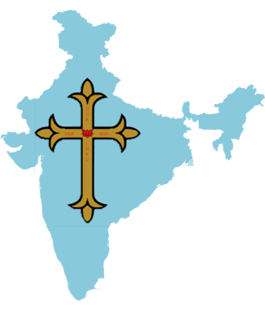

.jpg)
